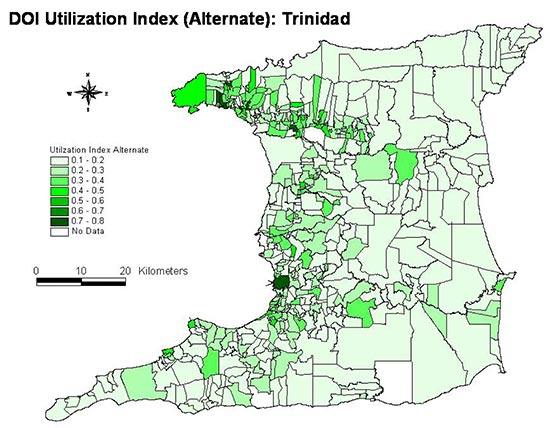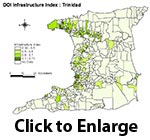BitDepth 637 - July 22
22/07/08 09:03 Filed in: BitDepth - July 2008
The Digital Divide in Trinidad and Tobago breaks out pretty much as you might expect it to, but there are some surprises.
The Digital Divide, 2007

The report's data is intimidatingly thorough, but the visual representations offer real insight into the Internet availability and use in Trinidad and Tobago. This map offers a guide to Internet use in Trinidad and Tobago.
The final report on the Digital Divide in Trinidad and Tobago, 2007 has been posted to the website of the Telecommunications Authority of Trinidad and Tobago.
Prepared by Dr Patrick K Watson and Dr Bheshem Ramlal of UWI's Sir Arthur Lewis Institute of Social and Economic Studies, the 135 page document is pretty much what you'd expect from an academic survey, rich with statistical detail with some timid conclusions.
The report makes a careful distinction between digital opportunity, which findings suggest is acceptably high, from utilisation, which is abysmally low.
In some areas, infrastructure build out is poor, but some services are available using wireless connections via either mobile phones or mobile broadband.
 At least three of the conclusions by the authors; improve the communications infrastructure, encourage the use of the Internet and reduce the cost of broadband services are almost annoyingly mundane and have been the backbeat of this column for more than ten years now.
At least three of the conclusions by the authors; improve the communications infrastructure, encourage the use of the Internet and reduce the cost of broadband services are almost annoyingly mundane and have been the backbeat of this column for more than ten years now.
But one of their suggestions, that more emphasis should be placed on mobile broadband Internet service, clearly comes out of the report's correlations between geography and access and is worthy of some commercial attention. If the government wants to make the Internet more accessible, this is a powerful lever point.
Internet services that focus on the wireless delivery of broadband can leapfrog the mile by mile issues of infrastructure build out and stalling factors such as cable theft.
The Digital Divide authors stop short of anything more potent than advice, but there are no such constraints here.
TSTT is currently the only provider of a truly mobile broadband Internet service but has dramatically slowed its expansion of the service for more than a year now.
The market for such services has also been constrained by the cost to consumers, which suggests that there may be room for competitive challenge of the monopoly provider of mobile broadband Internet by rival ISPs or a Digicel willing to step out of its GSM comfort zone to add 3G or HDSPA data services to its menu of offerings.
TATT has recently begun talking about a Universality fund, which proposes a system of subsidy for underserved areas, but that's a whole other discussion.
Surprising facts about digital T&T
Trinidad and Tobago has more mobile phones in use than there are people on the ground.
Mobile cellular access averages a dollar per minute; Internet access costs 9.6 cents per minute.
The overall Digital Opportunity Index has risen from 0.45 in a 2006 International Telecommunications Union report to 0.6315 in the TATT survey.
According to Ministry of Education figures, 305 schools are connected to the Internet via dial-up and 20 schools which are wired for DSL broadband. Ten of those schools are secondary schools in St George West.
Nalis reports that 283 people access the Internet monthly at the National Library, with 17,000 users at their other 23 library locations.
Two geographic areas of Trinidad, Canaree and Penal Quinam Beachroad are said to have five or fewer residents. No information was available to the authors for Pasea Extension, an area bounded on the west by St Augustine South and on the north by Trincity and Dinsley.
Areas of surprising population density to utilisation ratios include Speyside, Chaguaramas and Pointe a Pierre. Other utilisation hotspots include Tobago in the Scarborough-Bacolet area in the southwestern end of the island and La Horquette and Goodwood Gardens in the northwest of Trinidad.
Unsurprising facts about digital T&T
Internet connectivity and use varies according to income levels and availability.
Internet infrastructure and utilisation tends to follow population concentrations and heavily travelled traffic routes but rises sharply in higher income areas.
Service providers blew off the report's authors, claiming confidentiality and offering little useful data. Data was gathered using previous census data and household surveys of 6,000 households. Information about library Internet access was supplied by Nalis, the Ministry of Education provided information about Internet service in schools and TATT gathered information about Internet cafés.
Download the report in PDF format here.

The report's data is intimidatingly thorough, but the visual representations offer real insight into the Internet availability and use in Trinidad and Tobago. This map offers a guide to Internet use in Trinidad and Tobago.
The final report on the Digital Divide in Trinidad and Tobago, 2007 has been posted to the website of the Telecommunications Authority of Trinidad and Tobago.
Prepared by Dr Patrick K Watson and Dr Bheshem Ramlal of UWI's Sir Arthur Lewis Institute of Social and Economic Studies, the 135 page document is pretty much what you'd expect from an academic survey, rich with statistical detail with some timid conclusions.
The report makes a careful distinction between digital opportunity, which findings suggest is acceptably high, from utilisation, which is abysmally low.
In some areas, infrastructure build out is poor, but some services are available using wireless connections via either mobile phones or mobile broadband.

But one of their suggestions, that more emphasis should be placed on mobile broadband Internet service, clearly comes out of the report's correlations between geography and access and is worthy of some commercial attention. If the government wants to make the Internet more accessible, this is a powerful lever point.
Internet services that focus on the wireless delivery of broadband can leapfrog the mile by mile issues of infrastructure build out and stalling factors such as cable theft.
The Digital Divide authors stop short of anything more potent than advice, but there are no such constraints here.
TSTT is currently the only provider of a truly mobile broadband Internet service but has dramatically slowed its expansion of the service for more than a year now.
The market for such services has also been constrained by the cost to consumers, which suggests that there may be room for competitive challenge of the monopoly provider of mobile broadband Internet by rival ISPs or a Digicel willing to step out of its GSM comfort zone to add 3G or HDSPA data services to its menu of offerings.
TATT has recently begun talking about a Universality fund, which proposes a system of subsidy for underserved areas, but that's a whole other discussion.
Surprising facts about digital T&T
Trinidad and Tobago has more mobile phones in use than there are people on the ground.
Mobile cellular access averages a dollar per minute; Internet access costs 9.6 cents per minute.
The overall Digital Opportunity Index has risen from 0.45 in a 2006 International Telecommunications Union report to 0.6315 in the TATT survey.
According to Ministry of Education figures, 305 schools are connected to the Internet via dial-up and 20 schools which are wired for DSL broadband. Ten of those schools are secondary schools in St George West.
Nalis reports that 283 people access the Internet monthly at the National Library, with 17,000 users at their other 23 library locations.
Two geographic areas of Trinidad, Canaree and Penal Quinam Beachroad are said to have five or fewer residents. No information was available to the authors for Pasea Extension, an area bounded on the west by St Augustine South and on the north by Trincity and Dinsley.
Areas of surprising population density to utilisation ratios include Speyside, Chaguaramas and Pointe a Pierre. Other utilisation hotspots include Tobago in the Scarborough-Bacolet area in the southwestern end of the island and La Horquette and Goodwood Gardens in the northwest of Trinidad.
Unsurprising facts about digital T&T
Internet connectivity and use varies according to income levels and availability.
Internet infrastructure and utilisation tends to follow population concentrations and heavily travelled traffic routes but rises sharply in higher income areas.
Service providers blew off the report's authors, claiming confidentiality and offering little useful data. Data was gathered using previous census data and household surveys of 6,000 households. Information about library Internet access was supplied by Nalis, the Ministry of Education provided information about Internet service in schools and TATT gathered information about Internet cafés.
Download the report in PDF format here.
blog comments powered by Disqus

